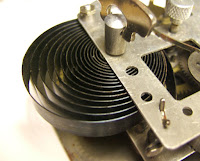 |
| Kinetrol uses a torsion spring as the motive force for their actuator spring return. |
Torsion (clock) springs posses a natural tendency to expand, producing a cumulative torque that increases as the spring is wound tighter. Both ends of the torsion spring are attached to other, separate components. When one component rotates around the center point of the spring, the spring will increasingly try to return to the original state. When a torque is applied to a spiral torsion spring, an angular displacement is created between the first and second loading points. The coil then deflects (tightens), and the spring material is placed under stress, which in turn exerts a linear rotational "output" torque.
 |
| An internal view of the clock spring. You'll note similarities with the Kinetrol spring return unit. |
Practically speaking, spiral torsion springs allow for lower torque loss, lower torque stress, and much greater reliability for use in valve and damper actuation.
Advantages of the torsion spring:
- High torque delivery per unit of deflection
- Low cost
- Compact
- Reliable
- Adjustable